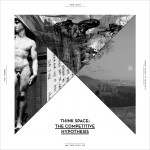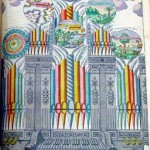Codex 99 features a rich article on Fritz Kahn, German gynaecologist and popular science writer from the 1910’s to the 1960’s.
Apart from writing articles on popular science for publishing house Kosmos’s ‘Gesellschaft der Naturfreunde’ magazine, Fritz Kahn also authored many books on a variety of subjects: Die Milchstrasse (The Milky Way) in 1914, Die Zelle (The Cell) in 1919, and, starting from 1921, the five volumes of Das Leben des Menschen (The Life of Man).

The seven functions of the nose (1939)
Das Leben was an encyclopedic work of 1600 pages and 1200 illustrations depicting biology as industrial and mechanical processes, adopting the most avant-garde visual techniques and contemporary styles as Neue Sachlichkeit, Dada, Surrealism, and also Constructivist photomontage.

Man as Industrial Palace (1926), enclosed as poster in the book “Fritz Kahn – Man Machine / Maschine Mensch”

The speed of thought, 1943

The effect of sunlight, 1940

The cycle of Virtue and Substance, ca.1929

The physiology of vision, 1931

The depths of a wound, 1943
Banned from Nazi Germany (Kahn was a prominent Jew), he escaped from Germany and, after a series of travels across Europe and the Middle East, he finally settled in the US, where he was able to publish two more books: Unser Geschlechtsleben5 (Our Sex Life) in 1935 and Der Mensch gesund und krank, Menschenkunde (Man in Structure and Function), a distillation from Das Leben, in 1940. Although selling well in the US, Kahn’s work was nonetheless heavily criticized: “The most noteworthy feature of the publication consists in its 461 well reproduced illustrations, many of which are highly imaginative and most are instructive to a rare degree,” but also stated “At times, however, the desire for originality has gone to almost absurd extremes.” (from The Quarterly Review of Biology).
His return to Europe, in the 1950’s was less fortunate, as Kahn further work was progressively failing in popularity. Almost forgotten, he was finally rediscovered only forty years after his death, in 1968.
More info about Kahn’s life and work:
Borck, C. Communicating the Modern Body: Fritz Kahn’s Popular Images of Human Physiology as an Industrialized World. Canadian Journal of Communication 1994 32(3): 495-520, which is available online, or, von Debschitz, Uta and Thilo. Fritz Kahn – Man Machine. New York: Springer, 2009. Available here.
Informations and some images via: Codex 99
Original scans courtesy of:
Frank Darrow, the NLM and Fritz Kahn’s Man Machine website
Similar works already published on Socks:
O.M. Ungers, City Metaphors
MinJeong Ahn, An Autobiography in Diagrams
Fernando Vicente, Anatomias
A compendium of anatomically correct or absolutely surreal Head Sections
Nikolai Lutohin, Sci-fi illustrations from 70’s Yugoslavia
Cycle Masturbation Machines, Jan Švankmajer, 1972-1973
McKnight Kauffer’s The World in 2030
“The Architect’s Brain”, illustration by Point Supreme for Conditions
Mechanical Animals, collages by Diego Gráfico
Hidden structures and other illustrations by Vincent Broquaire
Oliver Sacks Covers, By Cardon Webb

Fairytale journey along the bloodstream (1924)

How dessert cleans the tongue (1943)

Vibration-free montage in technology and nature: astronomical telescope and blood vessel in the ear (1929)

This is what occurs in our head when we see and say “Auto” 1943

The blood corpuscles, joined together in a chain, would span the globe 4 times, 1943

We see with the occipital area of the brain! 1943

The cycle of carbon dioxide, ca.1929.

Man is an “eye” animal: a dog is a “nose” animal, 1943

The work of the heart, 1943

The mammary gland, 1943

Respiration, 1943

The spinal cord, 1943

The eruption dates of the milk teeth, 1943

Erection – technical-schematic presentation of the male erection system (1937)

The doctor of the future (1925)

The perception of light (1929)

A technical miracle – the small human abdominal cavity houses 8.5 meter of intestines. (1926)

The congruence between the autotype and retinal image (1931)

Car and ear match (1929)

Muscle and doorbell connections in their five-part congruence (1924)

The biology of a roast’s smell (1926)

Man eats 1400 times his weight in 70 years. (1926)

The heart’s work performance (1936)

The principles of heat insulation in man and a thermos flask (1926)

Respiration (1926)

The architecture of digestion (1939)

The five most important routes of the spinal cord, in their course and functions demonstrated on a soccer player. (1939)





This could be interesting as well. My animated version of the Industrial Palace:
http://vimeo.com/6505158
Cheers,
Henning
very well done! will post that soon.
thank you.
fosco
Thanks for posting these wonderful illustrations. I’ve been looking for those images of the body as a factory for a long time. Saw them in a children’s encyclopedia in the ’40s. No, I didn’t end up as a doctor, sondern Übersetzer.
Our book “Fritz Kahn – Man Machine” (SpringerWienNewYork 2009) is sold out. But we published a new version of the Kahn monograph: “Fritz Kahn” (Taschen 2013), containing more illustrations (392 pages) for a less price. Check out our project website to learn more.
I feel it really is rather disrespectful to not mention the names of the illustrators that Kahn developped the illustrations with that are presented here. Maybe that is something that could still be added.
Dear Charlotte, as far as we know Kahn was the author of the illustrations. If you know more about other possible illustrators, please share this information.